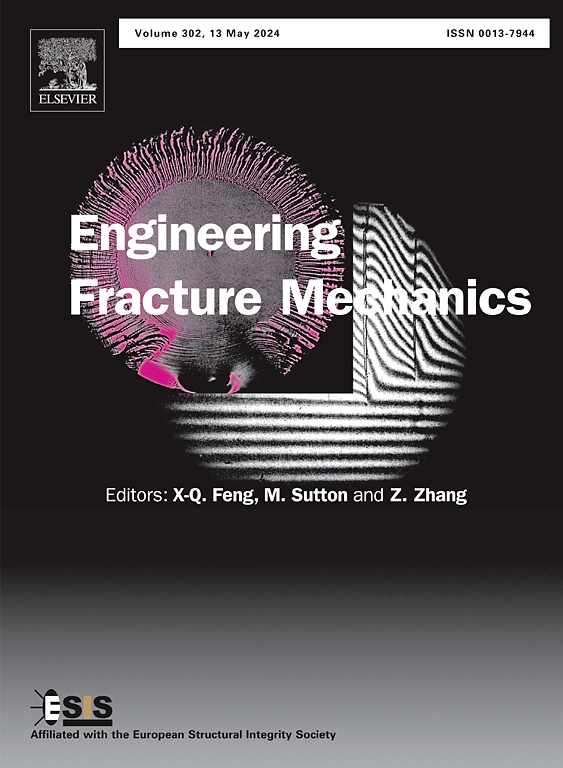Genetic programming-based multi-objective optimization for enhancing fracture performance in nanolayer-reinforced asphalt mixtures to estimate the initial quality and maintenance life
IF 4.7
2区 工程技术
Q1 MECHANICS
引用次数: 0
Abstract
In this study, the fracture behavior of hot mix asphalt (HMA) and warm mix asphalt (WMA) reinforced with two nanolayer additives called molybdenum disulfide nanoparticles (MDSN) and reduced graphene oxide nanoparticles (RGON) was investigated in two time periods, the beginning of exploitation and four years after exploitation. In this regard, the effective fracture toughness (Keff-I/II), fracture energy (FE), fracture flexibility, including flexibility index (FI), toughness index (TI), and cracking resistance index (CRI), fracture stiffness (FS), including tensile stiffness index (TSI) and tensile strength (TS), and damage factor (DF) were examined. Finally, to ensure the accuracy of the results, the Pearson correlation coefficient (PCC) statistical method was employed to analyze the correlation between the fracture indices. Moreover, the genetic programming (GP) model was used to provide a prediction model for obtaining optimum MDSN and RGON contents in CRI and TSI models using multi-objective optimization (MO). The results showed that RGON and MDSN reinforced mixtures showed acceptable performance against tensile-shear deformations under 0 and 1 freeze–thaw cycles (FTC) cycles. Also, 0.6 and then 0.3 % MDSN and RGON had the best performance regarding fracture toughness, energy, flexibility and stiffness, but, MDSN mixtures were better than RGON mixtures. PCC analysis showed a strong correlation between fracture resistance and stiffness, highlighting the interdependence of these properties. GP model results indicated that the relationship between predicted and actual values of CRI and TSI was appropriately described by R values of 99.23 and 98.42 % for CRI model and 98.96 and 98.57 % for TSI model of HMA, and 99.19 and 98.52 % for CRI and 98.95 and 98.96 % for TSI model of WMA mixtures modified with MDSN and RGON, respectively. MO results showed that 0.539 and 0.514 % for HMA and 0.562 and 0.427 % for WMA were the best optimal MDSN and RGON contents to simultaneously maximize CRI and TSI values, respectively. These findings provide valuable insights for policymakers and project managers, highlighting the potential of MDSN and RGON nanomaterials to significantly enhance the durability and cost-effectiveness of both HMA and WMA pavements.
基于遗传规划的纳米层增强沥青混合料断裂性能多目标优化,以估计初始质量和维护寿命
在这项研究中,研究了热拌沥青(HMA)和温拌沥青(WMA)在开发开始和开发后4年两个时间段内的断裂行为,研究了两种纳米层添加剂——二硫化钼纳米颗粒(MDSN)和还原性氧化石墨烯纳米颗粒(RGON)的增强。为此,检测了有效断裂韧性(Keff-I/II)、断裂能(FE)、断裂柔韧性(包括柔韧性指数(FI)、韧性指数(TI)、抗裂性指数(CRI)、断裂刚度(FS)(包括拉伸刚度指数(TSI)、拉伸强度(TS))、损伤因子(DF)。最后,为了保证结果的准确性,采用Pearson相关系数(PCC)统计方法对骨折指标之间的相关性进行分析。此外,利用遗传规划(GP)模型对CRI和TSI模型中MDSN和RGON含量的多目标优化(MO)提供了预测模型。结果表明:RGON和MDSN增强混合料在0次和1次冻融循环(FTC)下具有良好的抗拉剪变形性能;在断裂韧性、能量、柔韧性和刚度方面,以0.6%和0.3%的MDSN和RGON表现最好,但MDSN比RGON表现更好。PCC分析显示抗断裂性和刚度之间有很强的相关性,突出了这些特性的相互依赖性。GP模型结果表明,HMA的CRI模型的R值分别为99.23和98.42%,TSI模型的R值分别为98.96和98.57%,MDSN和RGON修正的WMA混合物的CRI和TSI模型的R值分别为99.19和98.52%,98.95和98.96%,可以很好地描述CRI和TSI预测值与实际值的关系。MO结果表明,HMA含量为0.539和0.514%,WMA含量为0.562和0.427%时,可同时最大化CRI和TSI值。这些发现为决策者和项目经理提供了有价值的见解,突出了MDSN和RGON纳米材料在显著提高HMA和WMA路面的耐久性和成本效益方面的潜力。
本文章由计算机程序翻译,如有差异,请以英文原文为准。
求助全文
约1分钟内获得全文
求助全文
来源期刊
CiteScore
8.70
自引率
13.00%
发文量
606
审稿时长
74 days
期刊介绍:
EFM covers a broad range of topics in fracture mechanics to be of interest and use to both researchers and practitioners. Contributions are welcome which address the fracture behavior of conventional engineering material systems as well as newly emerging material systems. Contributions on developments in the areas of mechanics and materials science strongly related to fracture mechanics are also welcome. Papers on fatigue are welcome if they treat the fatigue process using the methods of fracture mechanics.

 求助内容:
求助内容: 应助结果提醒方式:
应助结果提醒方式:


